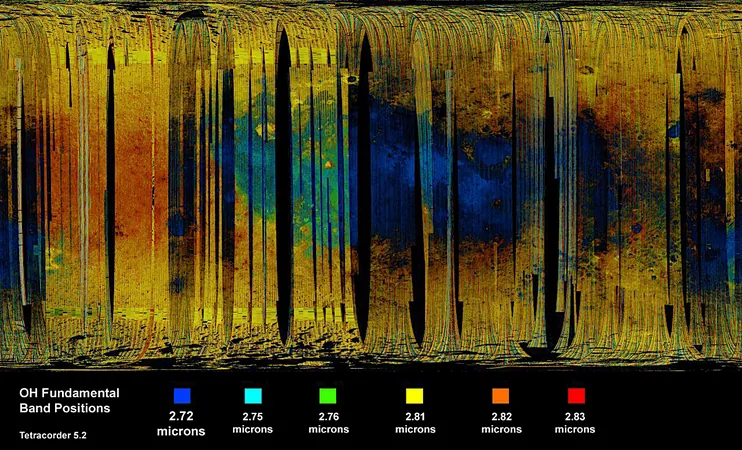
Discoveries Reveal Abundant Water and Hydroxyl Sources on the Moon - A Game Changer for Future Lunar Missions!
2024-09-16
Exciting Breakthrough in Lunar Research
In an exciting breakthrough, recent analyses of lunar maps have unveiled that the Moon is host to multiple sources of water and hydroxyl, even in sunlit regions. This surprising finding changes previous assumptions that water was primarily concentrated in the shadowy polar craters. Roger Clark, Senior Scientist at the Planetary Science Institute and lead author of the study published in the Planetary Science Journal, emphasized the significance of these findings for future astronauts. 'They may be able to find water near the equator by exploring these newly identified water-rich areas,' he remarked.
Utilization of Advanced Technology
The research team, which includes esteemed scientists such as Neil C. Pearson and Thomas B. McCord, utilized data from the Moon Mineralogy Mapper (M3), an imaging spectrometer aboard India’s Chandrayaan-1 spacecraft. From 2008 to 2009, the M3 mapped the lunar surface with unprecedented detail, allowing researchers to detect water and hydroxyl in both the near and far sides of the Moon.
Detecting Water and Hydroxyl
The method of detection involved sophisticated infrared spectroscopy, which analyzes the sunlight reflected off the lunar surface to identify the signatures of water (H2O) and hydroxyl (OH). Unlike standard cameras that see just three colors, the M3 instrument captured 85 different wavelengths, enabling a thorough analysis of the Moon's composition.
Practical Implications of Water Discoveries
Water on the Moon is not just a scientific curiosity but holds practical implications for future explorations. Astronauts could extract water by heating rocks and soils, or even generate it through chemical reactions involving hydroxyl. However, the study noted that water is metastable on the lunar surface; it slowly dissipates over millions of years, while hydroxyl remains more stable.
Geological Processes Underpinning Water Migration
The researchers deduced that cratering and volcanic activities are integral processes that can transport water-rich materials to the surface—factors they observed in the lunar data. The Moon comprises two main rock types: basaltic, found in the dark mare regions, and lighter andesitic rocks found in the lunar highlands. Notably, andesitic rocks are rich in water, while basalts contain scant amounts.
Daily Fluctuations of Water and Hydroxyl
Interestingly, the study revealed that the strength of water and hydroxyl absorption on the lunar surface fluctuates with the time of day, suggesting that there could be movement of these compounds on a daily cycle. The analysis showed that stable mineral absorptions, particularly in silicate minerals like pyroxene, also displayed these daily effects, reinforcing the need for further studies to quantify the layers within the lunar soil.
Unveiling the Secrets of Lunar Swirls
Another captivating finding from this research is the emergence of lunar swirls—enigmatic features that appear as diffuse patterns in light. Previous hypotheses attributed their formation to magnetic fields that divert solar wind and impact hydroxyl production. The new study confirmed that lunar swirls contain lower water and hydroxyl content and are generally higher in pyroxene, suggesting a more complex surface history than previously understood.
New Features and Future Explorations
Most astonishingly, researchers identified new features reminiscent of swirls that did not exhibit visible light patterns but were detectable in hydroxyl absorption. This hints at the possibility of ancient, eroded swirls and indicates that the lunar surface is far more intricate than scientists ever imagined.
Conclusion
With these groundbreaking insights, the Moon is opening up new avenues for exploration and could become a crucial resource hub for future lunar missions. As we continue to unveil the secrets of our cosmic neighbor, the prospects are not just about scientific discovery, but the potential for sustaining human presence beyond Earth.
Stay tuned for more fascinating updates on lunar research as we venture deeper into the mysteries of the Moon!





 Brasil (PT)
Brasil (PT)
 Canada (EN)
Canada (EN)
 Chile (ES)
Chile (ES)
 España (ES)
España (ES)
 France (FR)
France (FR)
 Hong Kong (EN)
Hong Kong (EN)
 Italia (IT)
Italia (IT)
 日本 (JA)
日本 (JA)
 Magyarország (HU)
Magyarország (HU)
 Norge (NO)
Norge (NO)
 Polska (PL)
Polska (PL)
 Schweiz (DE)
Schweiz (DE)
 Singapore (EN)
Singapore (EN)
 Sverige (SV)
Sverige (SV)
 Suomi (FI)
Suomi (FI)
 Türkiye (TR)
Türkiye (TR)